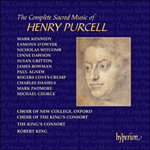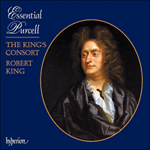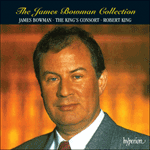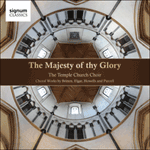
Welcome to Hyperion Records, a British classical label devoted to presenting high-quality recordings of music of all styles and from all periods from the twelfth century to the twenty-first.
Hyperion offers both CDs, and downloads in a number of formats. The site is also available in several languages.
Please use the dropdown buttons to set your preferred options, or use the checkbox to accept the defaults.

| Temple Church Choir, The Temple Players, James Vivian (conductor), Greg Morris (organ)» More |
The opening of the Te Deum is as spacious as one would expect: the two trumpets enter into vigorous dialogue with the strings, whilst the bass violins enjoy their repeated bottom Ds. The trio of male soloists appears first, taking on the trumpets’ vigorous dotted opening motif, and Purcell reserves the full choir for the section ‘All the earth doth worship thee’, where the build-up on ‘all’ is especially effective. Compositional devices abound in the setting, and ‘the Father everlasting’ is the first example of these, with Purcell demonstrating his masterly control of close counterpoint in both voices and instruments.
Pictorialisation too is everywhere: the solo trio melismatically picture the angels crying aloud, two solo boys imitate Cherubim and Seraphim, and the full forces enter for three block-busting chords on the word ‘holy’. Heaven and earth are represented graphically, the alto and high tenor’s dotting covering celestial matters, the bass left alone and low to reflect our earthly state, and the full assembly pictures the full majesty of God’s glory. Next, each of the three male soloists takes on a role: the alto tells of the ‘glorious company of Apostles’, the tenor more lyrically shows the ‘goodly fellowship of the Prophets’, and the bass portrays the firm and ‘noble army of Martyrs’ before once again all join together, trumpets in defiant octaves, to portray the Church throughout the world.
The Holy Trinity is pictured in matched pairs of voices, linked by a pair of solo violins: vocal melismas represent the infinite majesty of the Father, a second pair of boys the Son, and the two alto voices the Holy Ghost. Next comes an extraordinary piece of double counterpoint, ‘Thou art the King of Glory’, where two themes, one strongly rising, the other more rhythmic and falling, combine effortlessly in seven parts, the trumpets rising above the whole ensemble before block chords end the section. A more intimate atmosphere is created with the alto and bass duet ‘When thou took’st upon thee to deliver man’, full of word-painting: the sharpness of death is enhanced with a diminished chord, and the Kingdom of Heaven is opened with a rising phrase before the two boys once again interrupt in close imitation at ‘Thou sittest at the right hand of God’.
A brief trio ‘We believe that thou shalt come to be our judge’ and another interpolation from the boys introduce one of the most remarkable moments of the work. The text is now supplicatory (‘O Lord, save thy people’) and Purcell is immediately on his best territory with ardent repetitions of the word ‘save’. But the finest moment is kept back: with the two octave rising phrase ‘and lift them up for ever’, starting in the bass, transferring to the tenor and finally taken up by the countertenor, rising to the top of his register, we have one of the most glorious vocal phrases in Baroque music. Another short imitative chorus ‘Day by day’ follows, jubilant and ingenious as ever in its tight counterpoint.
The centrepiece of the work, which finds Purcell at his most personal, is ‘Vouchsafe, O Lord’, set for the composer’s favourite countertenor voice. It is a genuine plea from the heart, made all the more poignant when we realise that exactly a year later Purcell himself was dead. Here is the composer at his profound best, piling up sequences and dissonances and pleading for mercy in the most ravishing vocal and string writing. The serenity with which the movement ends, and the strong affirmation of the final chorus, suggests that this is one prayer which may be answered.
Whilst in his setting of the Te Deum Purcell utilises for the most part quite short sections (perhaps because he has a lot of text to set), in the shorter Jubilate he achieves longer musical spans. The opening is an extended duet between the countertenor and a solo trumpet, quite restrained in its joyfulness except in three interruptions by the full orchestra and choir. Once again it is in the more pastoral movements that Purcell shines best, with the duet between boy treble and countertenor ‘Be ye sure that the Lord he is God’ an especially touching one in its simplicity: Purcell’s use of sequence and gentle harmony creates a movement full of pathos. Next comes a rather austere four-part canon, ‘O go your way into his gates’ which is followed by an extended duet for countertenor and bass; again the plea for mercy draws Purcell into particularly effective writing.
The contrapuntal techniques employed in the Gloria are quite breathtaking. First the theme is treated to close imitation (‘Glory be to the Father’), then is inverted and imitated (‘Glory be to the Son’) and then, at ‘World without end’ a new theme is added, treated to the same techniques as before but also stretched out in the bass in a huge and powerful augmentation. At the final Amen the strands come together and, with the trumpets’ entries soaring above the whole choir and orchestra, a work of great technical and musical ingenuity ends in a blaze of sound.
from notes by Robert King © 1992
L'introduction du Te Deum est aussi considérable que l'on peut s'y attendre: les deux trompettes commencent un vigoureux dialogue avec les cordes, pendant que les basses de violons se délectent à répéter leurs ré les plus bas. Les premières voix sont celles du trio d'hommes solistes; elles reprennent le vigoureux motif pointé initial des trompettes, et Purcell réserve le choeur entier pour la section ‘All the earth doth worship thee’ quand la tension sur le mot ‘all’ est remarquable. La composition de cette mise en musique déborde d'invention. ‘The Father everlasting’ en est le premier exemple: Purcell y démontre sa parfaite maîtrise de proche contrepoint à la fois dans les voix et dans les instruments. Le passage entier n'est qu'imagerie: le trio solo illustre en mélismes les sanglots des anges, les deux garçons solos imitent Chérubin et Séraphin, et les forces entières attaquent avec trois accords explosants sur le mot ‘Holy’. Le Ciel et la terre sont représentés graphiquement: l'image du monde céleste est donnée par le pointage du haute-contre et du ténor, tandis que la basse profonde et solitaire reflète notre état terrestre; quant à l'assemblée entière, elle illustre la majesté totale de la gloire de Dieu. Ensuite, chacun des trois solistes hommes assume un rôle: le haute-contre parle de la ‘Glorieuse compagnie des Apôtres’, le ténor dépeint plus lyriquement la grande confrérie des Prophètes' et la basse, la solide et ‘noble armée des martyrs’ avant que de nouveau tous s'unissent, les trompettes en octaves provoquants, pour représenter l'Eglise à travers le monde.
La sainte Trinité est représentée par des paires égales de voix, qu'unissent deux violons solos: des mélismes vocaux illustrent la majesté infinie du Père, une seconde paire de jeunes sopranos représentent le Fils, et les deux voix haute-contre sont le Saint Esprit. Vient ensuite un extraordinaire exemple de contrepoint double, ‘Thou art the King of Glory’, quand deux thèmes, l'un s'élevant avec vigueur, l'autre plus rythmique et descendant, s'unissent sans aucun effort en sept parties, les trompettes dominant l'ensemble entier avant que des accords bloqués ne terminent la section. Une atmosphère plus intime est créée avec le duo de haute-contre et basse `When thou look'st upon thee to deliver man', riche d'imagerie: la cruauté de la mort est intensifiée par un accord diminué, et une phrase ascendante ouvre le Royaume des Cieux avant que les deux jeunes sopranos n'interrompent, une fois encore, avec une étroite imitation à ‘Thou sittest at the right hand of God’. Un bref trio ‘We believe that you shall come to be our judge’ et une autre interpolation des garçons introduisent un des moments les plus remarquables de cet hymne liturgique. Le texte est maintenant implorant (‘O Lord, save thy people’) et Purcell peut s'en donner à coeur òùjoie avec d'ardentes répétitions du mot ‘save’. Mais le meilleur moment est encore à venir: avec la phrase ascendante de deux octaves ‘and lift them up for ever’, qui commence dans la basse, passe dans le ténor et finalement est reprise par le haute-contre, dont la voix monte jusqu'à plus haut de son registre, nous avons ici une des plus splendides phrases de musique baroque. Un autre bref choeur imitatif ‘Day by day' suit, radieux et aussi ingénieux que jamais avec son contrepoint serré.
Purcell laisse entrevoir ses sentiments les plus intimes dans le passage le plus séduisant de l'hymne liturgique, ‘Vouchsafe, O Lord’, écrit pour la voix haute-contre préférée du compositeur. C'est un véritable cri du coeur, d'autant plus poignant que nous savons que Purcell n'avait plus qu'un an à vivre. Ici le compositeur révèle toute sa profondeur. Il produit l'écriture la plus ravissante qui soit pour voix et pour cordes, comblée de séquences et dissonances, pour implorer la clémence des Cieux. La sérénité avec laquelle le mouvement se termine et la vigoureuse affirmation du choeur final suggère que c'est une prière qui a été entendue.
Jubilate Deo. Purcell ne se sert en général que de courtes sections dans sa mise en musique du Te Deum (peut-être parce qu'il avait une quantité importante de texte à adapter). Mais dans le Jubilate, qui est plus court, il écrit de plus longs passages musicaux. L'introduction est un long duo entre le haute-contre et une trompette solo, sobre dans sa gaieté, sauf dans trois interruptions par l'orchestre et le choeur entiers. Une fois encore, les mouvements d'expression les plus champêtres sont les meilleurs. Par exemple, le duo entre un jeune soprano et le haute-contre ‘Be you sure that the Lord he is God’ est particulièrement touchant dans sa simplicité. Purcell crée un mouvement plein de pathétique à l'aide d'une harmonie coulante et de séquence. Vient ensuite un canon à quatre parties plutôt austère ‘O go your way into his gates’, qui est suivi d'un long duo pour haute-contre et basse: là encore Purcell implore la clémence des Cieux avec une écriture remarquablement belle. Les techniques contrapuntiques dont il se sert dans le Gloria sont étourdissantes: le thème est d'abord soumis à une étroite imitation (‘Glory be to the Father’) puis il est inversé et imité (‘Glory be to the Son’) et finalement, à ‘world without end’ un nouveau thème s'y ajoute, soumis aux mêmes techniques que précédemment, mais qui, aussi, s'étend jusqu'à la basse, la quitte, y retourne, dans une large et puissante augmentation. A l'Amen final, tous les thèmes sont réunis et, à l'attaque des trompettes dominant le choeur et l'orchestre entiers, une oeuvre de grande ingéniosité musicale et technique prend fin dans un embrasement sonore.
extrait des notes rédigées par Robert King © 1992
Français: Alain Midoux
Die Eröffnung des Te Deums ist so raumgreifend, wie man es erwarten würde: Die beiden Trompeten treten in energischen Dialog mit den Streichern, während die Baßviolinen sich ihrer wiederholten tiefen Ds erfreuen. Das Trio aus männlichen Solisten tritt als erstes in Erscheinung und nimmt das kräftig punktierte Eröffnungsmotiv der Trompeten auf. Purcell hält den vollständigen Chor bis zum Abschnitt ‘All the earth doth worship thee’ [Die ganze Erde huldigt dir] zurück, wenn der Aufbau bei ‘all’ besonders wirkungsvoll ist. Es wimmelt in dieser Vertonung von Besonderheiten der Komposition, und ‘the Father everlasting’ [dem Vater allezeit] ist das erste Beispiel dafür; hier demonstriert Purcell seine meisterhafte Beherrschung des eng geführten Kontrapunkts sowohl bei den Gesangs- als auch bei den Instrumentalparts. Auch Klangmalerei ist allerorts vorhanden: Das Trio der Solisten versinnbildlicht melismatisch die laut weinenden Engel, zwei solistische Knabenstimmen stellen Cherub und Seraph dar, und das volle Aufgebot stimmt beim Wort ‘holy’ [heilig] drei sensationelle Akkorde an. Himmel und Erde werden dadurch veranschaulicht, daß Alt und hoher Tenor punktierend für die himmlischen Angelegenheiten zuständig sind, während der Baß allein und tief unser Erdendasein widerspiegelt, das volle Ensemble die ganze Majestät von Gottes Herrlichkeit. Als nächstes übernimmt jeder der drei männlichen Solisten eine Rolle: Der Alt berichtet von ‘the glorious company of Apostles’ [der prächtigen Apostel Schar]; der Tenor verweist lyrischer auf ‘the goodly fellowship of the Prophets’ [die prächtige Bruderschaft der Propheten], und der Baß auf das standfeste und ‘noble army of Martyr’ [edle Heer der Märtyrer], ehe sich wieder alle mitsamt den Trompeten in trotzigen Oktaven zusammentun, um die weltumspannende Kirche vor Augen zu führen.
Die Heilige Dreifaltigkeit wird mittels gleicher Stimmpaare dargestellt, verknüpft durch zwei Soloviolinen: Gesungene Melismen verkörpern die unendliche Majestät des Vaters, ein zweites Knabenpaar den Sohn und die beiden Altstimmen den Heiligen Geist. Als nächstes folgt eine außergewöhnliche Passage doppelten Kontrapunkts, und zwar bei ‘Thou art the King of Glory’ [Du bist der Herr der Herrlichkeit], wo sich zwei Themen, eines steil ansteigend, das andere rhythmischer und abfallend, mühelos siebenstimmig vereinen, während die Trompeten sich über das gesamte Ensemble aufschwingen; dann beenden Blockakkorde den Abschnitt. Mit dem Duett ‘When you took'st upon thee to deliver man’ [Da du auf dich genommen, die Menschheit zu erlösen] zwischen Alt und Baß wird eine intimere Atmosphäre voller Wortmalerei erzeugt: Die Bitterkeit des Todes wird durch einen verminderten Akkord betont, und das Königreich des Himmels öffnet sich mit einer ansteigenden Phrase, bevor die beiden Knaben erneut in enger Imitation bei ‘Thou sittest at the right hand of God’ [Der du sitzest zur Rechten Gottes] unterbrechen. Ein kurzes Trio singt ‘We believe that thou shalt come to be our judge’ [Wir glauben an deine Bestimmung als unser Richter], und ein erneuter Einschub der Knaben leitet einen der bemerkenswertesten Momente des Werks ein. Der Text ist nun demütig (‘O Lord, save thy people’ [O Herr, rette dein Volk]), und Purcell ist sogleich in seinem Element, indem er das Wort ‘save’ inbrünstig wiederholen läßt. Doch der schönste Moment steht noch bevor: Mit der über zwei Oktaven ansteigenden Phrase ‘and lift them up for ever’, die im Baß anfängt, auf den Tenor übertragen und schließlich vom Countertenor aufgenommen wird, um die höchsten Bereiche von dessen Register zu erklimmen, liegt uns eine der erlesensten Gesangsphrasen der Barockmusik vor. Ein weiterer kurzer imitativer Chor auf ‘Day by day’ [Tag für Tag] folgt, frohlockend und einfallsreicher denn je in seinem straffen Kontrapunkt.
Kernstück des Werks, das Purcell von seiner persönlichsten Seite zeigt, ist ‘Vouchsafe, O Lord’ [Gewähre, o Herr] für die Lieblingsstimme des Komponisten, den Countertenor. Dies ist ein von Herzen kommendes echtes Bittgebet, das umso ergreifender wird, wenn wir uns klarmachen, daß Purcell selbst genau ein Jahr später starb. Hier gibt der Komponist sein Tiefgründigstes und Bestes, indem er Sequenzen und Dissonanzen aufhäuft und mit hinreißender Gesangs- und Streicherkomposition um Gnade fleht. Die stille Heiterkeit, mit der der Satz endet, und die starke Bekräftigung des Schlußchors lassen vermuten, daß dies ein Gebet ist, welches erhört werden könnte.
Jubilate Deo. Während sich Purcells Vertonung des Te Deum meistenteils recht kurzer Abschnitte bedient (vielleicht, weil er viel Text zu vertonen hatte), erzielt er beim kürzeren Jubilate längere Musikspannen. Die Eröffnung ist ein ausgedehntes Duett zwischen dem Countertenor und einer Solotrompete und recht zurückhaltend in seiner Freudigkeit, ausgenommen drei Unterbrechungen von seiten des gesamten Orchesters und Chors. Auch diesmal sind es die eher pastoralen Sätze, mit denen Purcell wahrhaft glänzt; einer davon, ein Duett zwischen Knabensopran und Countertenor, ist besonders rührend in seiner Schlichtheit: Purcells Einsatz von Sequenzen und sanfter Harmonik schafft hier eine Vertonung voller Pathos. Als nächstes kommt ein recht karger vierstimmiger Kanon auf ‘O go your way into his gates’ [Durchschreitet dankend seine Tore]; es folgt ein längeres Duett für Countertenor und Baß; das Flehen um Gnade veranlaßt Purcell erneut zu besonders effektvoller Stimmführung. Die kontrapunktischen Techniken, die beim Gloria Anwendung finden, sind regelrecht atemberaubend: Zunächst wird das Thema in enger Imitation verarbeitet (‘Glory be to the Father’ [Ehre sei dem Vater]), dann wird es invertiert und imitiert (‘Glory be to the Son’ [Ehre sei dem Sohn]); bei ‘World without end’ [Welt ohne Ende] wird ein neues Thema hinzugefügt, den gleichen Verfahren unterzogen wie gehabt, aber auch auf den Baß ausgedehnt zu einer gigantischen und eindrucksvollen Augmentation. Beim abschließenden Amen kommen die einzelnen Stränge zusammen, und mit einem Einsatz der Trompeten, die sich noch einmal über den gesamten Chor und das Orchester aufschwingen, endet ein Werk von großer technischer und musikalischer Genialität in aufloderndem Klang.
aus dem Begleittext von Robert King © 1992
Deutsch: Anne Steeb/Bernd Müller
 Purcell: The Complete Sacred Music Purcell: The Complete Sacred Music‘It is hard to speak too highly of this enterprise … much enjoyment to be had’ (Gramophone) ‘The performances from The King’s Consort and its Choir, the Choir of New College and a starry line-up of soloists have such qualities of concentratio ...» More |
 Essential Purcell Essential Purcell'Not to be missed… the gateway to an absolute treasure trove of delights' (BBC Music Magazine) 'Magnificent performances of Purcell masterpieces' (In Tune, Japan) 'This is the winner among inexpensive samplers, and highly recommended. Almost ... » More |
 The James Bowman Collection The James Bowman Collection'The James Bowman Collection' deserves the strongest and warmest of recommendations … This is glorious music-making and deserves the widest possible hearing' (The Daily Telegraph) 'La intensa expresividad, la técnica y el color de la voz d ... » More |
 The Majesty of thy Glory The Majesty of thy GloryThis magnificient programme sung by The Temple Church Choir explores three fascinating and contrasting settings of the Te Deum: A stalwart of the church liturgy (first conceived as far back as AD 387), these settings span over 300 years of English ...» More |

